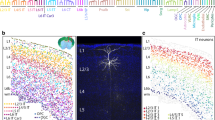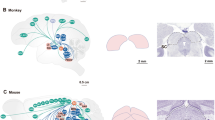Summary
-
1.
Escape swimming behavior inTritonia diomedea consists of two major components: an initial reflexive withdrawal followed by a series of alternating ventral and dorsal flexions. The basic mechanism of generating motor neuron activity, therefore, switches from reflexive to centrally programmed.
-
2.
Three classes of cerebral interneurons and some of their synaptic connections have been identified.
-
3.
Reflexive withdrawal interneurons (RWI) receive direct input from sensory afferents and synapse with motoneurons in the pedal ganglion (DFN, VFN). This class of interneuron is excited during reflexive withdrawals and inhibited during the swim phase.
-
4.
Swim interneurons (SI) are excited during reflexive withdrawals and burst during the swim phase.
-
5.
The third set of interneurons (C2) are shown to be necessary for the normal initiation and maintenance of the cyclical swim phase. Activity in C2 neurons appears to retrigger the swim oscillator network cycle-by-cycle.
-
6.
C2 neurons inhibit the RWI neurons during swimming thus freeing motoneurons to respond predominantly to inputs from the SI and C2 neurons. The switch from reflexive to programmed motor output is, therefore, mediated centrally by two identified C2 neurons.
Similar content being viewed by others
References
Abraham, F.D., Willows, A.O.D.: Plasticity of a fixed action pattern in the sea slug,Tritonia diomedia. Comm. Behav. Biol. (A)6, 271–280 (1971)
Calabrese, R.: Crayfish mechanoreceptive interneurons. I. The nature of ipsilateral excitatory inputs. J. comp. Physiol.105, 83–102 (1976)
Dorsett, D.A., Willows, A.O.D., Hoyle, G.: Centrally generated nerve impulse sequences determining swimming behavior inTritonia. Nature224, 711–712 (1969)
Dorsett, D.A., Willows, A.O.D., Hoyle, G.: The neuronal basis of behavior inTritonia. IV. The central origin of a fixed action pattern demonstrated in the isolated brain. J. Neurobiol.4, 287–300 (1973)
Friesen, O.W., Poon, M., Stent, G.S.: An oscillatory neuronal circuit generating a locomotory rhythm. Proc. nat. Acad. Sci.73, 3734–3738 (1976)
Gerschenfeld, H.M., Tauc, L.: Différent aspects de la pharmacologie des synapses dans le système nerveux central des mollusques. J. Physiol. (Paris)56, 360–361 (1964)
Getting, P.A.:Tritonia swimming: triggering of a fixed action pattern. Brain Res.96, 128–133 (1975)
Getting, P.A.: Afferent neurons mediating escape swimming of the marine mollusc,Tritonia. J. comp. Physiol.110, 271–286 (1976)
Koester, J., Mayeri, E., Liebeswar, G., Kandel, E.R.: Neuronal control of circulation inAplysia. II. Interneurons. J. Neurophysiol.37, 476–496 (1974)
Mulloney, B., Selverston, A.I.: Organization of the stomatogastric system of the spiny lobster. III. Coordination of the two subsets of the gastric system. J. comp. Physiol.91, 53–78 (1974)
Shik, M.L., Orlovsky, G.N.: Neurophysiology of locomotor automatism. Physiol. Rev.56, 465–401 (1976)
Willows, A.O.D.: Behavioral acts elicited by stimulation of single identifiable brain cells. Science157, 570–574 (1967)
Willows, A.O.D.: Behavioral acts elicited by stimulation of single identifiable nerve cells. In: Physiological and biochemical aspects of nervous integration (ed. F.D. Carlson), pp. 217–243. Englewood Cliffs, N.J.: Prentice-Hall (1968)
Willows, A.O.D.: Interactions between brain cells controlling swimming in a mollusc. In: Neurobiology of invertebrates (ed. J. Salanki), pp. 233–247. New York: Plenum Press. Budapest: Akadémiai Kiado 1973
Willows, A.O.D., Dorsett, D. A., Hoyle, G.: The neuronal basis of behavior inTritonia. I. Functional organization of the central nervous system. J. Neurobiol.4, 207–237 (1973a)
Willows, A.O.D., Dorsett, D.A., Hoyle, G.: The neuronal basis of behavior inTritonia. III. Neuronal mechanism of a fixed action pattern. J. Neurobiol.4, 255–285 (1973b)
Willows, A.O.D., Hoyle, G.: Neuronal network triggering a fixed action pattern. Science166, 1549–1551 (1969)
Author information
Authors and Affiliations
Additional information
I thank Dr. A.O.D. Willows, Director, Friday Harbor Laboratories, University of Washington, Friday Harbor, WA. 98250 for providing facilities during the months of July and August. I also thank Drs. S. Thompson, J. Wine, and B. Mulloney for careful criticism of the manuscript, as well as Paul Taggert and Richard Hume for helpful discussions and the sharing of results during the course of this research. Supported by N.I.H. research grant number NS12529.
Rights and permissions
About this article
Cite this article
Getting, P.A. Neuronal organization of escape swimming inTritonia . J. Comp. Physiol. 121, 325–342 (1977). https://doi.org/10.1007/BF00613012
Received:
Issue Date:
DOI: https://doi.org/10.1007/BF00613012




